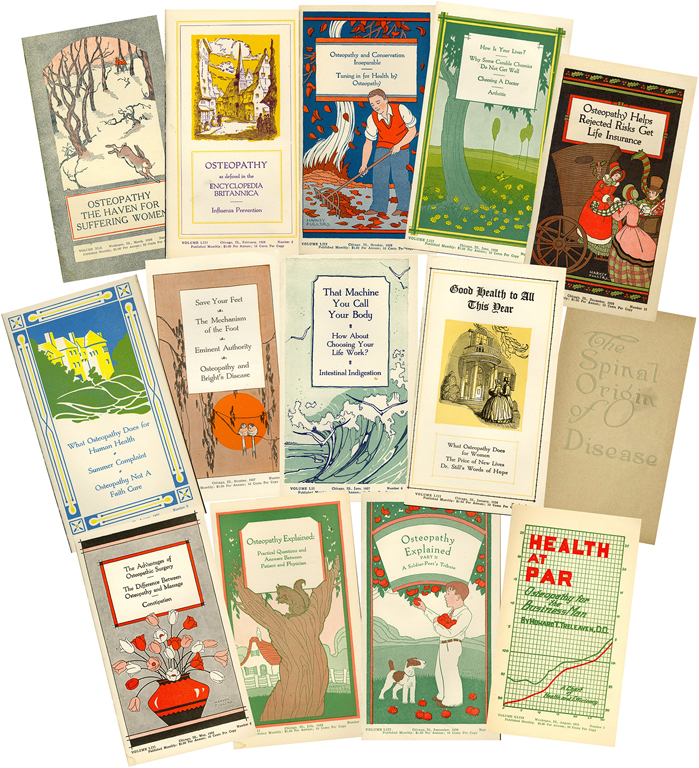Discovering Osteopathic Antiquity in Historical Osteopathic Pamphlets
-
Lori Fitterling
In the early 20th century, information about the osteopathic profession was circulated by way of pamphlets, leaflets, and brochures (Figure). These publications exhibited striking illustrations and explanations of the benefits of osteopathic medicine. To preserve these iconic sources of osteopathic history, the D'Angelo Library at the Kansas City University of Medicine and Biosciences has begun a digitization project that includes 23 osteopathic pamphlets, originally published from 1910 to 1928.1

Covers of osteopathic pamphlets published in the 1920s.
These eye-catching pamphlets were produced by 3 publishers: Williams Publishing Co, Bunting Publishing Co, and the American Osteopathic Association. The pamphlets were marketed as literature that would explain the benefits of maintaining good health and inform people about osteopathy. The Bunting Publishing Co had a unique pamphlet distribution method. They solicited patient mailing lists from osteopathic physicians and offered patients a 1-year subscription to the pamphlet. Physicians paid a fee to have their professional cards inserted into the pamphlets sent out to the recipients on the list they provided.2
The pamphlets covered various subjects, including taking care of one's liver and the ways in which osteopathy could benefit women.3,4 A prevalent theme was the broad scope of osteopathy. One pamphlet, Health at PAR: Osteopathy for the Business Man, exemplified how the osteopathic principle of maintaining one's health was regarded. Treleaven explains,
The field of Osteopathy is limited only by those comparatively few diseases in which the pathologic destruction of the tissues has gone so far that regeneration is physically impossible and for which there is no known cure. Its practice actually includes all of mankind's ailments which the general practitioner of any system is called on to treat. It is common sense, combined with the application of physiologic laws, in the correction and prevention of abnormal influences which cause human illness and suffering.5(p15)
This common sense, combined with the application of physiologic laws, illustrates an early osteopathic emphasis on using good judgement coupled with science in the prevention of disease, which resonates in osteopathic practice today.
The osteopathic medical field is in great debt to the resolve of these early promotors for inspiring the profession. By preserving these historical pamphlets, members of the osteopathic medical community can better understand the osteopathic approach to patient care today.
References
1. Early osteopathic literature. D'Angelo Library Digital archive website. http://kcumb.contentdm.oclc.org/cdm/landingpage/collection/p16788coll3. Accessed November 28, 2017. Search in Google Scholar
2. Gevitz N. The DOs: Osteopathic Medicine in America. 2nd ed. Baltimore, MD: Johns Hopkins University Press; 2004:64.Search in Google Scholar
3. Bunting HS . Osteopathy the haven for suffering women.Osteopath Health.1926;19(3).Search in Google Scholar
4. Walmsley AG. How is your liver? Osteopath Health. 1928;53(6):3-8.Search in Google Scholar
5. Treleaven H. Health at PAR Osteopathy for the Business Man. 1924:1-15.Search in Google Scholar
© 2018 American Osteopathic Association
This work is licensed under the Creative Commons Attribution-NonCommercial-NoDerivatives 4.0 International License.
Articles in the same Issue
- THE SOMATIC CONNECTION
- Stand Up and Climb Out of Ankle Spasticity
- OMT MINUTE
- OMT for Cancer Patients After Bowel Resection
- STILL RELEVANT
- Discovering Osteopathic Antiquity in Historical Osteopathic Pamphlets
- LETTERS TO THE EDITOR
- Chronic Pain Management: Perspective of an Osteopathic Medical Student in New Mexico
- ORIGINAL CONTRIBUTION
- Variations in Progression and Regression of Precancerous Lesions of the Uterine Cervix on Cytology Testing Among Women of Different Races
- Medical Student Decision-Making: Standard Surgical Excision or Mohs Micrographic Surgery to Manage Basal Cell Carcinoma
- BRIEF REPORT
- Evaluating the Effectiveness of One-on-One Conversations to Increase Colorectal Cancer Screening in a Community-Based Clinical Setting
- JAOA/AACOM MEDICAL EDUCATION
- Effect of Ultrasonography on Student Learning of Shoulder Anatomy and Landmarks
- CASE REPORT
- Toxic Injury to the Gastrointestinal Tract After Ipilimumab Therapy for Advanced Melanoma
- Nephroblastoma Arising in a Primary Testicular Teratoma in a Nonatrophic Testis of a 50-Year-Old Man
- THE SOMATIC CONNECTION
- It Makes a Difference What You Are Thinking When You Touch Someone Clinically
- OMT May Be Helpful in the Management of Benign Paroxysmal Positional Vertigo
- CSF Flow Has a Significant Respiratory Component
- Lymphatic Vessels Found in the Brain—Osteopathic Considerations, Part 2: Now in Humans and Monkeys
- CLINICAL IMAGES
- Pott Puffy Tumor
- IN YOUR WORDS
- Gratitude: Reflections and Belonging in the Osteopathic Family
Articles in the same Issue
- THE SOMATIC CONNECTION
- Stand Up and Climb Out of Ankle Spasticity
- OMT MINUTE
- OMT for Cancer Patients After Bowel Resection
- STILL RELEVANT
- Discovering Osteopathic Antiquity in Historical Osteopathic Pamphlets
- LETTERS TO THE EDITOR
- Chronic Pain Management: Perspective of an Osteopathic Medical Student in New Mexico
- ORIGINAL CONTRIBUTION
- Variations in Progression and Regression of Precancerous Lesions of the Uterine Cervix on Cytology Testing Among Women of Different Races
- Medical Student Decision-Making: Standard Surgical Excision or Mohs Micrographic Surgery to Manage Basal Cell Carcinoma
- BRIEF REPORT
- Evaluating the Effectiveness of One-on-One Conversations to Increase Colorectal Cancer Screening in a Community-Based Clinical Setting
- JAOA/AACOM MEDICAL EDUCATION
- Effect of Ultrasonography on Student Learning of Shoulder Anatomy and Landmarks
- CASE REPORT
- Toxic Injury to the Gastrointestinal Tract After Ipilimumab Therapy for Advanced Melanoma
- Nephroblastoma Arising in a Primary Testicular Teratoma in a Nonatrophic Testis of a 50-Year-Old Man
- THE SOMATIC CONNECTION
- It Makes a Difference What You Are Thinking When You Touch Someone Clinically
- OMT May Be Helpful in the Management of Benign Paroxysmal Positional Vertigo
- CSF Flow Has a Significant Respiratory Component
- Lymphatic Vessels Found in the Brain—Osteopathic Considerations, Part 2: Now in Humans and Monkeys
- CLINICAL IMAGES
- Pott Puffy Tumor
- IN YOUR WORDS
- Gratitude: Reflections and Belonging in the Osteopathic Family


